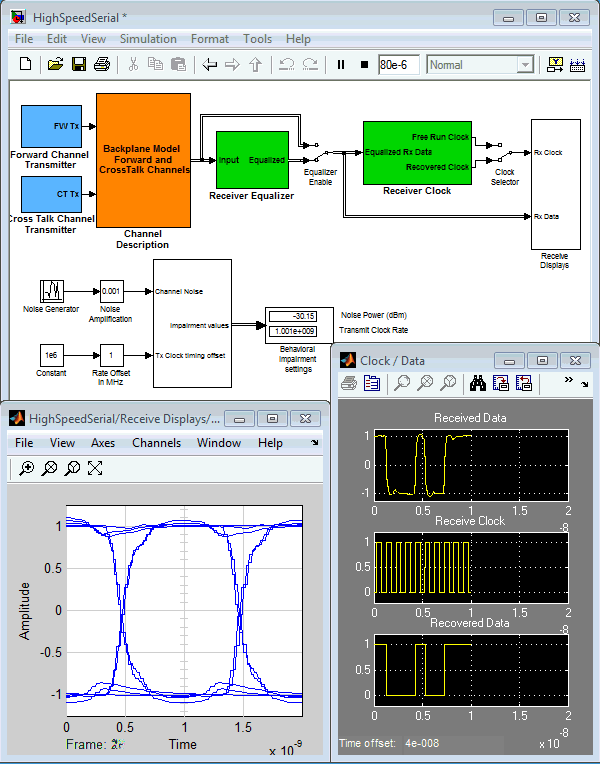Accelerating Mixed-Signal Design with Early Behavioral models
In the fast-paced world of high-speed mixed-signal systems, such as 200+ Gb/s SerDes, the demand for increased performance and complexity is ever-growing. Engineers are continuously seeking ways to optimize design cycles and reduce the likelihood of design issues. Components such as data-converters, clock synthesizers, power-converters and references, need to be constantly redesigned such that they are tolerant to process variations, temperature drifts, and supply voltage variations. One promising approach is the use of early behavioral models to streamline the design process. In this blog post, we’ll explore how early behavioral modeling can accelerate mixed-signal design and enhance system efficiency.
Figure 1: Typical receiver of a modern high-speed link
Interested to learn more? Visit our Semiconductor Design and Verification solutions site.
The Challenge of Mixed-Signal Systems
Mixed-signal systems integrate both analog and digital components, creating complex interactions that can lead to extended design cycles and increased risk of errors. As manufacturing processes evolve and performance requirements rise, the complexity of these interactions grows, making traditional design workflows less effective.
The Power of Early Behavioral Models
Early behavioral models offer a solution by allowing engineers to simulate and validate system components before the final design is complete. This approach involves using architectural models to generate behavioral mixed-signal simulation models, enabling a shift in the design validation effort to earlier in the workflow.
Benefits of Early Behavioral Modeling
- Rapid Design and Validation: By generating behavioral models early, different subsystems can be designed and validated in parallel. For example, in a SerDes system, an analog-to-digital converter (ADC) behavioral model can be used to design an ADC calibration scheme without waiting for the finalized ADC design. This parallel workflow reduces the overall design time and allows for more iterative improvements.
- Reduced Design Risk: Early validation helps identify potential issues before they become critical, reducing the risk of costly and time consuming redesigns. Engineers can address interaction complexities between analog and digital components early, ensuring smoother integration.
- Increased Flexibility : With behavioral models, designers can explore various design scenarios and optimizations without the constraints of physical prototypes. This flexibility leads to more innovative solutions and a better understanding of system behavior.
Figure 2: Comparing architectures or adding variations within one
Implementing Early Behavioral Models
To effectively implement early behavioral modeling in your design process, consider the following steps:
- Develop Architectural Models: Begin by creating detailed architectural models of your system. These models serve as the foundation for generating accurate behavioral simulations, both statistical and time-domain.
- Use the architectural models to automatically generate behavioral models for critical components. This step allows you to simulate and validate interactions between subsystems and compensation algorithms early in the design cycle.
- Export Models: Leverage the behavioral models to conduct parallel design and validation efforts, which later can be used to generate HDL code for the digital part, SystemVerilog code for the analog or even IBIS-AMI models. Encourage collaboration between teams working on different subsystems to ensure cohesive system integration from all aspects.
- Iterate and Optimize: Continuously refine and optimize your design based on insights gained from the behavioral models. Use feedback to make informed decisions and improve system performance.
Figure 3: System model with correction loop
Conclusion
Incorporating early behavioral models into your mixed-signal design workflow can significantly accelerate the design process, reduce risks, and enhance overall system performance. By enabling parallel design and validation, this approach allows engineers to tackle the complexities of high-speed mixed-signal systems more effectively. As the demand for advanced systems continues to grow, embracing early behavioral modeling will be key to staying ahead in the field.
Since this blog is a starting point highlighting the benefits of transforming your design process, we have planned subsequent activities for you to learn more. You can start with visiting the Semiconductors Design and Verification site to understand our solutions.
Share your thoughts and experiences in the comments below!
- Category:
- Semiconductors





Comments
To leave a comment, please click here to sign in to your MathWorks Account or create a new one.